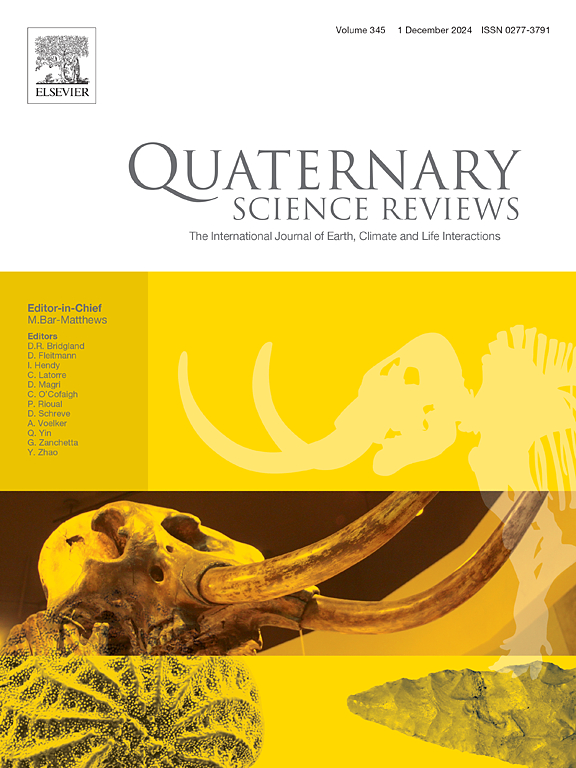Effects of climate and sea level change on sedimentation in the eastern Bengal Fan during the late Quaternary
IF 3.2
1区 地球科学
Q1 GEOGRAPHY, PHYSICAL
引用次数: 0
Abstract
The Bengal Fan is a vast repository of clastic sediments from the Himalayas, Peninsular India and Indo-Burman ranges. Many ancient submarine channels through which the turbidity currents operated in the Bay of Bengal are currently inactive. These defunct channels provide some of the best sediment records of continental weathering and climate. Here, we present the results of a sedimentological, geochemical, and Sr-Nd isotopic study done on a well-dated sediment core (27–1.5 kyrs BP) collected from the now-defunct submarine channel in the eastern Bay of Bengal to examine the roles of various environmental factors on the growth of the fan. Results of our study suggest that active fan progradation at the eastern margin of the Bengal basin continued until ∼12 kyrs BP, with rapid deposition of coarse-grained terrigenous flux. Deposition of sediments from Indo-Burman-Arakan (IBA) ranges and Ganga-Brahmaputra rivers through channel E7 was active during 27 to 12 kyrs. Subsequently, hemipelagic sedimentation from the Irrawaddy increased. Unlike other major fans, the Bengal Fan had a very active coarse-grained terrigenous flux during the Last Glacial Maximum and subsequent deglacial period. The post-12 kyr BP cessation of coarse-grained terrigenous deposition despite significant sediment influx from the Himalaya/Indo-Burman-Arakan Ranges was likely a result of the inland retreat of river mouths due to sea level rise and the subsequent detachment of the submarine channels from the coast. Our study also suggests that the sedimentation in the Bengal Fan is less sensitive to the variations in the rainfall associated with the Indian Summer Monsoon than the sea level changes. These findings underscore the complex interplay between the climate and coastal geomorphology in shaping the Bengal Fan.
晚第四纪气候和海平面变化对东孟加拉扇沉积的影响
孟加拉扇是一个巨大的碎屑沉积物储存库,这些碎屑沉积物来自喜马拉雅山、印度半岛和印度-缅甸山脉。在孟加拉湾,浊流流经的许多古代海底通道目前都处于不活动状态。这些消失的河道为大陆风化和气候提供了一些最好的沉积物记录。在这里,我们介绍了沉积学、地球化学和Sr-Nd同位素研究的结果,这些研究是对从孟加拉湾东部现已消失的海底通道收集的一个年代确定的沉积物岩心(27-1.5 kyrs BP)进行的,以检验各种环境因素对扇生长的作用。研究结果表明,孟加拉盆地东部边缘活跃的扇积作用一直持续到~ 12 kyrs BP,并伴有粗粒陆源通量的快速沉积。印度-缅甸-阿拉干(IBA)山脉和恒河-布拉马普特拉河通过E7通道的沉积物沉积在27至12年间活跃。随后,伊洛瓦底江的半深海沉积增加。与其他主要扇不同,孟加拉扇在末次盛冰期和随后的去冰期具有非常活跃的粗粒陆源通量。尽管来自喜马拉雅山脉/印度-缅甸-阿拉干山脉的大量沉积物涌入,但12 kyr BP后粗颗粒陆源沉积的停止可能是由于海平面上升导致河口内陆退缩以及随后海底通道从海岸分离的结果。我们的研究还表明,孟加拉扇沉积对与印度夏季风相关的降雨变化的敏感性低于海平面变化。这些发现强调了气候和海岸地貌在形成孟加拉扇中的复杂相互作用。
本文章由计算机程序翻译,如有差异,请以英文原文为准。
求助全文
约1分钟内获得全文
求助全文
来源期刊

Quaternary Science Reviews
地学-地球科学综合
CiteScore
7.50
自引率
15.00%
发文量
388
审稿时长
3 months
期刊介绍:
Quaternary Science Reviews caters for all aspects of Quaternary science, and includes, for example, geology, geomorphology, geography, archaeology, soil science, palaeobotany, palaeontology, palaeoclimatology and the full range of applicable dating methods. The dividing line between what constitutes the review paper and one which contains new original data is not easy to establish, so QSR also publishes papers with new data especially if these perform a review function. All the Quaternary sciences are changing rapidly and subject to re-evaluation as the pace of discovery quickens; thus the diverse but comprehensive role of Quaternary Science Reviews keeps readers abreast of the wider issues relating to new developments in the field.
 求助内容:
求助内容: 应助结果提醒方式:
应助结果提醒方式:


